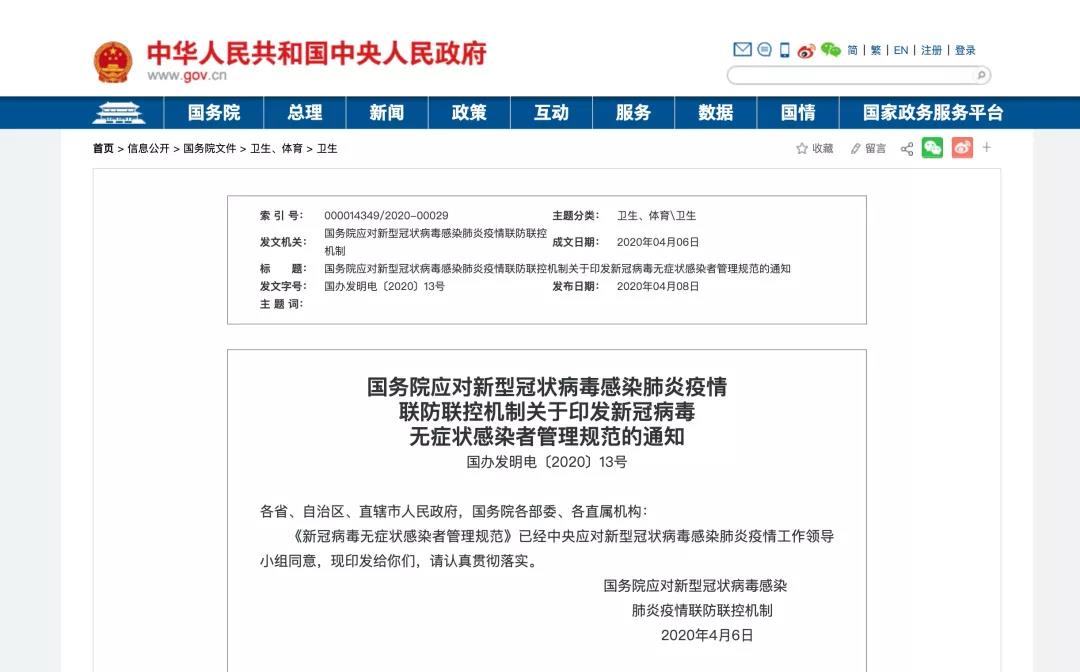9F, Zhongrui Jumei Building, 68 Jiuzhang Road, Suzhou Industrial Park, Jiangsu Province
Summit notice
How to manage asymptomatic infections? The latest notice from the State Council!
The State Council: In accordance with the Law of the People's Republic of China on the Prevention and Control of Infectious Diseases and the Frontier Health and Quarantine Law of the People's Republic of China, these Regulations are formulated to strengthen the detection, reporting and management of asymptomatic COVID-19 infections.

Notice of the State Council on the Joint Prevention and Control Mechanism for novel coronavirus Infection Pneumonia on the Issuance of Management Standards for Asymptomatic COVID-19 Infected Persons
Guo Ban Chuan Fa Dian [2020] No. 13
To the people's governments of various provinces, autonomous regions, and municipalities directly under the Central Government, as well as to the ministries and commissions of the State Council, and to the institutions directly under the State Council:
The Management Specification for Asymptomatic COVID-19 Infected Persons has been approved by the Central Leading Group for novel coronavirus Pneumonia, and is now printed and distributed to you. Please implement it carefully.
The State Council Responds to Pneumonia Caused by novel coronavirus
Joint epidemic prevention and control mechanism
April 6, 2020
Management specifications for asymptomatic COVID-19 infected persons
Article 1 These Regulations are formulated in accordance with the Law of the People's Republic of China on the Prevention and Treatment of Infectious Diseases and the Frontier Health and Quarantine Law of the People's Republic of China in order to strengthen the detection, reporting and management of asymptomatic COVID-19 infections.
Article 2 Asymptomatic COVID-19 infected persons (hereinafter referred to as asymptomatic infected persons) refer to those who have no relevant clinical manifestations, such as fever, cough, sore throat and other symptoms and signs that can be perceived or recognized clinically, but whose respiratory tract and other specimens are positive for COVID-19 etiology. There are two conditions for asymptomatic infections: first, after 14 days of isolation medical observation, there are no symptoms and signs that can be perceived or clinically recognized; The second is in the incubation period; ldquo; Asymptomatic infection; rdquo; Status.
Article 3 Asymptomatic infected persons are infectious and present a risk of transmission.
Article 4 Strengthen the monitoring and detection of asymptomatic infections: First, active detection of close contacts of COVID-19 cases during medical observation; The second is active detection in aggregated epidemic investigation; Third, active detection of exposed people in the process of tracking the infectious source of COVID-19 cases; Fourth, the active detection of some people with a history of living in areas where COVID-19 cases continue to spread at home and abroad; The fifth is related personnel found in epidemiological investigations and opportunistic screening.
Article 5 Standardize the reporting of asymptomatic infections. Medical and health institutions at all levels and types should report asymptomatic infections through the network within 2 hours. After receiving the report of asymptomatic infection, the county level disease control institution shall complete the case investigation within 24 hours, timely register close contacts, and timely report the case questionnaire or investigation report through the infectious disease reporting information management system. After the asymptomatic infected person is released from centralized medical observation, the medical and health institution should promptly fill in the date of release from medical observation in the infectious disease reporting information management system.
Article 6 Strengthen information disclosure. The health administrative department of the State Council publishes daily reports, outcomes, and management of asymptomatic infected persons. Each province (district, city) publishes its own administrative region, and reports statistics on local dissemination and overseas imports.
Article 7 Strengthen the management of asymptomatic infected persons. Asymptomatic infected persons should be under intensive medical observation for 14 days. During this period, patients with clinical symptoms and signs related to COVID-19 were transferred to confirmed cases. Centralized medical observation can be cancelled if the patient has been under centralized medical observation for 14 days and has tested negative for nucleic acid in two consecutive samples (the sampling time is at least 24 hours apart). If the nucleic acid test is still positive and there are no clinical symptoms, it is necessary to continue centralized medical observation.
Article 8 If asymptomatic infected persons exhibit clinical manifestations during centralized medical observation, they should be immediately transferred to designated medical institutions for standardized treatment, and promptly corrected after diagnosis.
Article 9 Close contacts of asymptomatic infected persons should be subject to centralized medical observation for 14 days.
Article 10 Organize an expert group to conduct a patrol inspection on asymptomatic infected persons under centralized medical observation, and timely discover possible confirmed cases.
Article 11 For asymptomatic infected persons who have been released from centralized medical observation, they shall continue to undergo 14 days of medical observation and follow-up. Visit a designated hospital for follow-up visits in the second and fourth weeks after the release of centralized medical observation to promptly understand their health status.
Article 12: Intensify targeted screening efforts and expand the scope of testing to close contacts of detected cases and asymptomatic infected persons. Intensive monitoring of key areas, key populations, and key locations should be carried out. Once asymptomatic infections are found, they should be intensively isolated for medical observation.
Article 13 Asymptomatic infected persons have the characteristics of concealment of transmission, subjectivity of symptoms, and limitations of discovery. The State supports the development of scientific research on the infectivity, transmissibility, and epidemiology of asymptomatic infected persons.
Article 14 Strengthen information communication, exchange and cooperation with relevant countries and international organizations such as the World Health Organization, and timely adjust diagnosis and treatment plans and prevention and control plans.
Article 15 All localities should strengthen the science popularization of COVID-19 knowledge, guide the public in scientific protection, carry out extensive training, and improve the prevention and control ability and level of grass-roots medical and health personnel and community workers.

